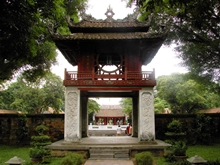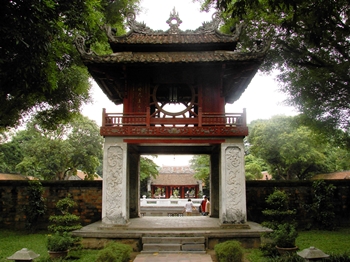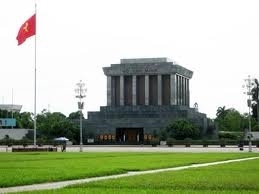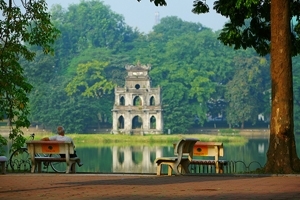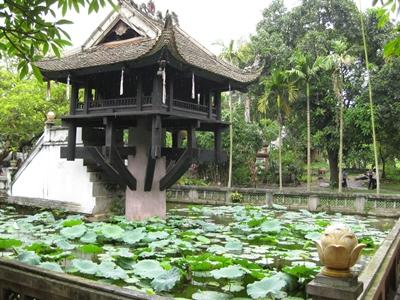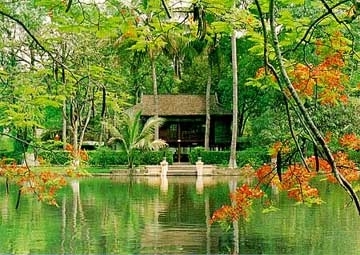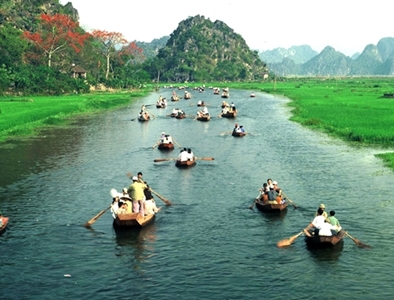QUICK FACT:
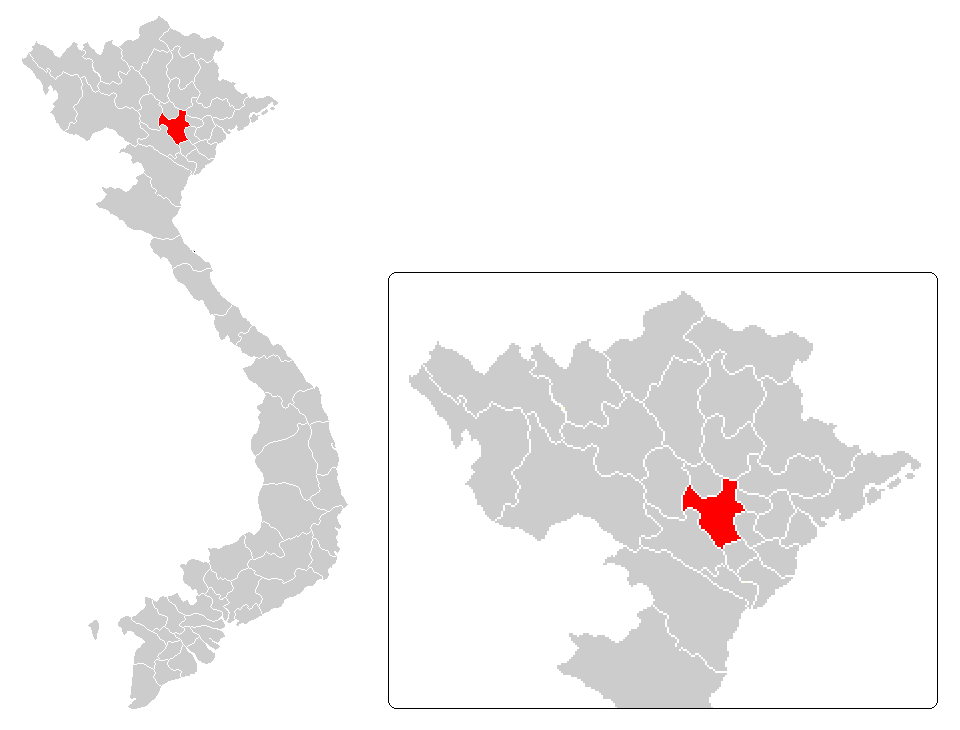
Vietnamese name: Hà Nội
Location: North Vietnam
Area: 1,285 mi²
Founded: 1010
Time Zone: ICT (UTC+07:00)
Population: 7.588 million (2015)
Area code: 04
Demonym: Hanoians
INTRODUCTION
Since its establishment as Vietnam’s capital, Hanoi has been a city of contrasts, from hidden coffee shops waiting to be discovered to the emerging con-temporary art galleries; from historical monuments to ancient pagodas and temples and luxurious designer stores. This fascinating city holds deeply its roots and sense of history and has welcomed the modern world. Today, Hanoi is a sophisticated and elegant city, bursting with character.
Hanoi was first established as Vietnam’s capital in 1010 when it was named Thang Long (literally meaning Ascending Dragon), but before that time, people settled this land back as far as the 3rd century BC. The city changed its name many times throughout history before the Nguyen dynasty gave it the modern name of Hanoi in 1831.
Today, the capital enjoys a rapid grown on both economy and society. The many skyscrapers popping up in new urban areas have changed the cityscape and formed a modern Hanoi beside the old city. Still, Hanoi remains much of its old charm of bygone eras, despite several invasions, occupations, restorations and battles that raged over it.
The Hanoians take great pride in their long-standing culture, their rich tradition, their world-famous cuisines, and their ultimate love for this city. And for the people of Vietnam, Hanoi had been and will always be their beloved capital for many years to come.
Being the capital of Vietnam for such a long time, Hanoi boasts a rich cultural heritage left by most Vietnamese dynasties. Not was that, in the colonial time, the city was modeled by the French with stylistic architectural relics that are still alive today.
In Hanoi, you might find yourself sipping some strong coffee or sitting at a street-side restaurant, slurping up a bowl of Bun cha while watching flows of people on motorbikes rushing by. It is Hanoi, a city to be savored.
WHEN TO GO
Hanoi’s weather is divided into two main seasons: rain season from January to September and the dry season from October to April, but thanks to transition moths, the city enjoy four distinct seasons in a year.
Hanoi’s spring from February to April is humid and wet with drizzles. Normally, the temperature is about 15 – 20 Celsius degree, a perfect condition for plants to bud and flowers to bloom. This is also the time for Tet – the most important holiday of Vietnamese people, to come.
A hot and humid summer lasts from May to August with July being the hottest moth. The average temperature is 32 Celsius degree and has risen up due to global warming. Get prepared for frequent rainfalls which is a feature of Hanoi’s summer.
Perhaps the most beautiful season of Hanoi is fall, from September to October. Despite being a short period, this season is characterized by a mild temperature, gentle sunlight and cool breeze. Hop on a plane to Hanoi in autumn and you will be treated to some of the most romantic landscapes in the world with a rusty riot of yellow and gold leaves, a slow pace of life and the fragrant Hoa Sua (milk flower) which has become a “specialty” of Hanoi autumn and go into the many songs and poetry for years.
Winter often starts from November to January with a cold and dry weather. Remember to bring warm clothes as at times the temperature drops below 10 Celsius degree. Imagine that can happen in a tropical country like Vietnam! If you visit the capital during winter, warm up your chilly day by sampling its famous street food.
It seems that best time to travel Hanoi is from September to November or from March to April when the weather is mild with temperature ranges from 18 to 30 Celsius degree.
GETTING THERE
Air: Although Hanoi has fewer direct international flights than Ho Chi Minh City, it has direct flights from Paris, Los Angeles, San Francisco, as well as most cities in East and Southeast Asia to Hanoi.
Noi Bai International Airport is located just 35km north of the city. Vietnam Airlines serves as the main carrier for both international and domestic flights that link Hanoi to all main cities throughout Vietnam. Popular routes are to Ho Chi Minh City, Hue, Da Nang, Nha Trang, Dien Bien Phu, and Da Lat with daily flights. Air Asia, Tiger Air, Korean Air, Cathay Pacific, China Airlines, Hong Kong Airlines, Lao Airlines, Lufthansa, Malaysia Airlines, Silk Air, THAI, United and Vladivostok Air also offers frequent flights to and from Hanoi. From Europe, visitors may have to transit in Paris or Hong Kong. From North America, most flights have a transit in Hong Kong, Tokyo, Osaka or Seoul.
From the airport, you have many options to get into the center such as the airline’s minibus, local bus, taxi or private car.
Train: Hanoi train station is about 10 minutes by car from the center. If you cross the border to Vietnam from China, you might board the train in Lao Cai and arrive in Hanoi in early morning. The Reunification railway linking Hanoi with Ho Chi Minh City offers travelers a comfortable and leisurely way to see Vietnam. The 1,726 km railway established during the French colonial rule begins in Hanoi, passes through 19 provinces and end in Ho Chi Minh City.
Road: Most of provinces in Vietnam have bus to and from Hanoi through three main bus stations: My Dinh, Giap Bat and Gia Lam.
Top things to do and see
Ngoc Son Temple sits on an island in Hoan Kiem Lake. The ramshackle Thap Rua (Turtle Tower), set on an islet near the southern end, is topped with a red star and is often used as the emblem of Hanoi.
Temple of Literature: Known as Vietnam’s first University and located 2 kilometers west of Hoan Kiem Lake, the Temple of Literature is a rare example of well-preserved traditional Vietnamese architecture. Founded in 1070 by Emperor Ly Thanh Tong, the temple is dedicated to Confucius and honors Vietnam’s finest scholars of literary accomplishment.
Visitors are welcomed by an imposing tiered gateway that leads through the gardens and to the Khue Van Pavilion, constructed in 1802. The northern side of this courtyard is marked by a low-slung pagoda housing an extraordinary statue of a majestic Confucius, depicted with a goatee and bearing scarlet robes, flanked by four of his disciples.
One Pillar Pagoda: The One Pillar Pagoda was originally built in 1049 by the Emperor Ly Thai Tong, who ruled from 1028 to 1054. The pagoda was built to honor the emperor’s peasant wife who bore him an heir. Built of wood on a single stone pillar, the pagoda is designed to resemble a lotus blossom, the symbol of purity. The original pagoda was destroyed in 1954 by the French upon their withdrawal from Vietnam. The present day pagoda was rebuilt by the government in the following year.
Hoan Kiem Lake: Legend claims that in the mid-15th century, Heaven sent Emperor Le Thai To (Le Loi) a magical sword, which he used to drive the northern invaders from Vietnam. After the war a giant golden turtle grabbed the sword and disappeared into the depths to restore the sword to its divine owners, thus inspiring the name Ho Hoan Kiem (Lake of the Restored Sword). Every morning, local residents practice traditional tai chi on the shore.
The Old Quarter: The Old Quarter is the heart and soul of the city. It first appeared in the 11th century after King Ly Thai To built his palace. Initially, as a group of workshop villages surrounding the royal palace, it then gradually transformed into craft cooperatives, thereby gaining its reputation as the business trading area of the Red River Delta. Constructed in a long and narrow style, the streets are a must when visiting Hanoi, as they provide an interesting adventure.
Ho Chi Minh Mausoleum Complex: This complex is a special place of pilgrimage for many Vietnamese who visit the area to pay homage to Hoi Chi Minh, leader of modern Vietnam. It is a traffic-free area of botanical gardens, monuments, memorials and pagodas. Within the complex are Ho Chi Minh's Mausoleum, Ho Chi Minh’s Stilt House and the Presidential Palace, as well as the Ho Chi Minh Museum.
Vietnam Museum of Ethnology: Vietnam Museum of Ethnology is both a research center and a public museum, exhibiting the ethnic groups of Vietnam. It also serves as a center for scientific research, collection, documentation, conservation, exhibition and preservation of cultural and historic patrimony of Vietnam’s different ethnic groups.
On the grounds are examples of traditional village houses of different ethnic minorities – a Tay stilt house, an impressive Bahnar communal structure and a Dao home. Don’t miss the soaring, thatch-roofed Giarai Tomb, complete with risqué wooden statues.
Tran Quoc Pagoda: The pagoda was built in the 6th century, giving it the title of the oldest Buddhist temple in Hanoi with an age of nearly 1,500 years old. It sits on an islet of West Lake and is linked to the mainland by a small causeway. With the harmonious architecture taking advantage of the watery landscape, Tran Quoc Pagoda is a serene place to visit. The sunset here over the vast lake are also renowned.
Water puppet show: This is unique traditional art of Vietnamese that dates back as far as the 11th century in the villages of the Red River Delta in North Vietnam. Puppets are made of wood then lacquered. Puppeteers who are normally hidden behind a screen controls these puppets through a complicated system of bamboo rod and string under the water in a waist-deep pool.
Travelers can enjoy a water puppet show at Thang Long Theatre located in Dinh Tien Hoang Street near Hoan Kiem Lake.
Cyclo: Take a cyclo tour around the Old Quarter for an hour or so is a worthwhile experience. The feeling of passing through small and bustling streets is somehow like a slow movie bring you back to an old Hanoi. So take the chance to board a cyclo to enrich your experience. And last but not least, deal the price with the driver before you get on.
What to eat & Where to enjoy:
Bún Chả – Barbecued Pork with Rice Vermicelli: The dish consists of grilled pork strips and balls or chả served over a bed of rice vermicelli noodles or bún.It typically comes with a plate of fresh Vietnamese herbs and a bowl of dipping sauce. Pickled vegetables, like cabbage, carrots, onion or green papaya served with additional meatballs on the side.
Where?
Chả Cá – Grilled Fish with Dill and Tumeric: The special ingredient in Chả Cá is grilled fish, typically mudfish or snake-head fish. According to the restaurant, the best fish to use Hemibragus, because it has fewer bones and tasty flesh.
Where?
Bánh Cuốn – Steamed Rice Rolls: Bánh cuốn is made of a thin rice sheet rolled and filled with ground pork meat and minced mushrooms. It is served with fried shallots and cilantro herbs on top.
Where?
Phở – Vietnamese Noodle Soup: the classic dish of Hanoi, this is aromatic soup filled with slices of beef, rice noodles and a plateful of fresh herbs.
Where?
- Phở Gia Truyền: No.49 Bat Dan
Bánh Mì – Vietnamese Sandwich: It is stuffed with pork, pâté, cured ham, a mélange of Vietnamese herbs and vegetables like coriander, cucumber, carrot, slices, radish and more depending on what part of the country you are in. A wealth of textures and flavors, you will savor spicy, salty, savory, sweet, and aromatic tastes in each bite.
Where?
Cà Phê Trứng - Vietnamese Egg Coffee: Although it is not a food, it is like food. Egg coffee or Ca Phe Trung is the most famous coffee in the north of Vietnam. It is a thick dark coffee topped with egg yolk whipped with condensed milk into an airy froth. Rich in taste, it can be likened to tiramisu dessert.
Where?
Hanoi Outskirt
Bat Trang ceramic village: Bat Trang is a village in North Vietnam about 13 kilometers south east of Hanoi, on the Red river. It has been famous for its ceramics for a thousand years, particularly dinnerware and ornamental ware.
Perhaps the most outstanding strength of Bat Trang village is its tradition of making pottery. The people are very skilful and talented, producing a product that has a distinctive look. Visiting Bat Trang, you can see the whole process of how a product is manually made. It is hot sweaty work, but the results are superb. Traditional quality pottery includes bowl, dish, pot, cup, wine pot, a big flower-vase, leg lamp, lime-pot, big-bellied jar with glazes such as ancient pearl blaze, crackle glaze, dark glaze, indigo-blue flower glaze, grey flower glaze, melt glaze... Craftsmanship developed over many generations.
Van Phuc silk village: Van Phuc village is in Ha Dong Town, Ha Tay Province, 10km from Hanoi. It is the oldest and most famous silk village in Vietnam, with products maintaining their popularity in national and international markets for hundreds of years. In the past, Van Phuc silk was used in costumes for the King and his family and senior officials. Now, Van Phuc silk is accessible to anyone who comes Hanoi, including fashion designers, who recently honored Van Phuc silk on the catwalk.
Right at the gate to Van Phuc village, travelers will see a number of silk shops, where they can choose any kind or color they want. Further inside the village, travelers can enjoy an ancient view of a northern Vietnamese village, with communal house and well, lotus pond, ancient banyan tree, and a market...all alongside modern houses.
Dong Ho painting village: Dong Ho is a small village in Thuan Thanh, Bac Ninh province, located on the southern side of the Duong river (30km to the east from Hanoi,) is one of the villages that remains to preserve ancient cultural relies of Kinh Bac area (red river delta, north of Vietnam.) Dong Ho paintings have about 300 years of history in the north of Vietnam.
Dong Ho folk painting is very famous because Dong ho is the only village where people know to make the "Dzo" painting with completely natural materials. The printing paper is made of bark of a tree called "Dzo." The background paper is originally white. People use natural materials to change the colors of the papers which are usually orange, pink, yellow, purple,.. Colors of the painting are refined from various kinds of tree leaves that people can easily find in Vietnam. The original point of Dong Ho folk painting is the durability of colors. The painting is covered by a layer of sticky rice paste (called "ho nep") to protect the painting and their colors. They are so long lasting, so that it is very difficult to make them dimmer even time or daylight.
Duong Lam village: Duong Lam Ancient Village is of cultural and historical importance and it attracts many tourists. The village is in Duong Lam Commune, about 60km from Hanoi. It consists of more than six hamlets. Among these hamlets, Mong Phu is the biggest and the most famous.
The village is a place to see for tourists from far and wide. It is included in tours of many travel companies. Two of its famous places are Sung Nghiem Tu (Mia Pagoda) and Mong Phu Temple. Mia Pagoda is on a small hill in Dong Sang Hamlet. It was constructed before 1632 and has been upgraded and restored many times. Now it is a national cultural and historical site. Mong Phu Temple is in Mong Phu Hamlet. It was set up with ancient Vietnamese architecture in 1638. In the village, tourists can also see ancient houses and small lanes as well as study the everyday life of residents.
One special thing about the village is that most of the buildings here are made of laterite and mud, two materials that are abundant in the area. Laterite is used on house walls, gates, wells, temple walls, and so forth. The mud is taken from ponds.
But Thap pagoda: This complex of buildings is situated on a dike of the Duong River amid rice farms. Like most Buddhist temples, a number of buildings actually comprise the temple, usually laid out in linear form, moving successively toward the center. Here the layout has an Entrance Porch, a Bell Tower, and then several central buildings-- for performance of rituals, burning of incense (where prayers are recited), and sanctuaries with statues of Buddhas and Bodhisattvas.
Perfume pagoda: Built into the limestone cliffs of Huong Tich Mountain (Mountain of Fragrant Traces), the Perfume pagoda is an amazing complex of temple, Buddhist shrines, mountains, streams and grottoes...
67 km out of Hanoi, it would take you one and half hour to get by car. You can spend another hours exploring the area. Start by a leisurely trip by boating on a river among a beautiful karstic landscape, then you hike quite a long trail to reach eventually the main sanctuary in a cave. Along the way, there are a great number of other places to worship. Perfume Pagoda is the most important religious area in Vietnam. Almost all Vietnamese Buddhists will make the pilgrimage here, to Perfume Pagoda at least once in their lives. Festive season is from 1st to 3rd Lunar month every year (between February and April) and the area becomes extremely crowded with local people.
Thay pagoda: Thay Pagoda (The Masters' Pagoda) is about 40 km from Hanoi, in Ha Tay province. The pagoda is dedicated to three cults: Sakyamuni, the founder of Buddhism surrounded with 18 arhats; The monk Tu Dao Hanh of Vietnam and King Ly Thanh Tong reincarnated from the teacher. From the top of Sai Son Hill, visitors can have a beautiful view of scenery. In front of the pagoda, there is a small stage built in the middle of a pond, which was used for puppet shows on festival days
Tay Phuong pagoda: This well-known pagoda, also called Sung Phuc was constructed in the 13th century on a buffalo shaped hill. There are 262 brick steps up. It comprises of 3 parallel buildings with splendid roofs. Tay Phuong Pagoda, is one of the finest pagodas In Vietnam with 76 statues of jack wood mark the great artistic value of the 18 century. The pagoda is surrounded by idyllically quaint villages in the Red River Delta.
Hanoi surrounding areas:
Hoa Binh
Hoa Binh is a mountainous province and the gateway to western Hanoi. Hoa Binh is a home of the Muong and Dao minority hill tribal people who live in traditional houses - on - stilts and maintain their diverse traditions and customs. The clean and grandiose nature with numerous scenic beauty spots, grottoes and caves in limestone valleys, primeval forests and romantic lakes to create and extremely charming landscape. A full day tour to Hoa Binh normally includes a visit to the hydro-electric dam of Hoa Binh Hydrogen Power Plant, the biggest one in the South East Asia; stopover to visit villages of Dzao and Muong Minorities. If you don't like to travel far to find the unique hill tribes of Vietnam, then Hoa Binh is where you should go.
Ninh Binh
Located as far as 100 kilometers south of Hanoi is Ninh Binh province, the south extreme of the Red River delta. Inside the province is the grandiose Tam Diep Mountain, connecting the North and the South. The province stretches from the Northwest mountainous area to the delta, thus being called a half mountain half plain area. In particular, Ninh Binh contains 3 main kinds of topography: limestone mountains with fascinating caves & grottoes, the delta raised by Red River Silt, and a coastline with the length of 18 kilometers, enlarging the province area by 100m2 per year.
Besides limestone caves and grottoes, Ninh Binh is also popular for the first imperial capital of Vietnam, from 968 to 1010 under Dinh, Le and Ly dynasties, which has resulted in its cultural tourism potential. Also, Tam Coc-Bich Dong and Cuc Phuong national park within the province are desirable destinations for tourists.
Destinations in Ninh Binh:
Hoa Lu ancient citadel: The very first meaningful stop-over in Ninh Binh should be Hoa Lu, the capital of Vietnam from 968 until 1010. In 968, Dinh Bo Linh defeated 12 lords of the district (former Vietnam) and proclaimed to be Emperor. He was the first King of Dinh dynasty (King Dinh Tien Hoang), and named the country Dai Co Viet. Then he set up Hoa Lu, his home country, as the capital of Dai Co Viet. His meaningful success was a great landmark of Vietnam as transferring from a thousand years under the rule of China into an truly independent nation.
Hoa Lu was an ideal place for a capital city because of both its distance from China and the natural protection provided by the region's landscape. Dinh dynasty lasted 12 years. Then Le Hoan started 29 years of Le dynasty. In 1009, when Ly Cong Uan became the King, he found an area which had an excellent site and topography, therefore decided to move the capital from Hoa Lu to Dai La citadel, former Hanoi. In 1910, Hoa Lu ended its honored role of being the Nation’s Capital after 42 years.
There are two sanctuaries, each of them devoted to the emperors of these two dynasties. They are set into a landscape of limestone mountains. This place is worth a visit if you are itching to get out of Hanoi to witness rural village life, admire a beautiful landscape and enjoy a very tranquil feel.
Tam Coc Caves: Tam Coc, which literally means three caves, is known to travelers as Vietnam's "Inland Halong Bay" with limestone mountains set amongst rice paddy fields. This area used to be under sea level some million years ago. Vestiges of the ocean still remain through the erosion of the mounts-Caves. In Tam Coc, you will be offered a leisurely sampan cruise on a creek across three vast stretches of rice field.
Phat Diem cathedral: If you are a Catholic, a famous Cathedral for visiting in Ninh Binh is Phat Diem Cathedral, which was built between 1875 and 1899 with four roofs and six sets of iron wooden pillars, and consists of a network of ponds, lakes, churches, and artificial caves. On both sides of the church are four smaller churches of different styles. In the area, the rice paddies are peppered with stone churches. But, unlike these structures, as built by Europeans and resembling typical churches of the era, Phat Diem Cathedral was designed by a Vietnamese priest, known as Father Sau. Father Sau rallied the local population to build the cathedral, five side chapels, three artificial grottoes, an artificial lake and a bell tower. Phat Diem Cathedral seems to have changed very little since Graham Greene described its gigantic pillars formed out of single trees and the scarlet lacquer work of the altar. Indeed, with its multi tiered, curling roofs and its 48 lime-wood columns - (the largest of which weigh seven tones), Phat Diem is a far cry from a European cathedral. Stone relief angels overlook carved dragons and the cathedral's two-tone bell is accompanied by a giant brass gong.
Whoever spending a few minutes inside the Cathedral, particularly the Stone Church, can easily feel the specially cool atmosphere and a classical religious space!
Hanoi & Surrounding
QUICK FACT:

Vietnamese name: Hà Nội
Location: North Vietnam
Area: 1,285 mi²
Founded: 1010
Time Zone: ICT (UTC+07:00)
Population: 7.588 million (2015)
Area code: 04
Demonym: Hanoians
INTRODUCTION
Since its establishment as Vietnam’s capital, Hanoi has been a city of contrasts, from hidden coffee shops waiting to be discovered to the emerging con-temporary art galleries; from historical monuments to ancient pagodas and temples and luxurious designer stores. This fascinating city holds deeply its roots and sense of history and has welcomed the modern world. Today, Hanoi is a sophisticated and elegant city, bursting with character.
Hanoi was first established as Vietnam’s capital in 1010 when it was named Thang Long (literally meaning Ascending Dragon), but before that time, people settled this land back as far as the 3rd century BC. The city changed its name many times throughout history before the Nguyen dynasty gave it the modern name of Hanoi in 1831.
Today, the capital enjoys a rapid grown on both economy and society. The many skyscrapers popping up in new urban areas have changed the cityscape and formed a modern Hanoi beside the old city. Still, Hanoi remains much of its old charm of bygone eras, despite several invasions, occupations, restorations and battles that raged over it.
The Hanoians take great pride in their long-standing culture, their rich tradition, their world-famous cuisines, and their ultimate love for this city. And for the people of Vietnam, Hanoi had been and will always be their beloved capital for many years to come.
Being the capital of Vietnam for such a long time, Hanoi boasts a rich cultural heritage left by most Vietnamese dynasties. Not was that, in the colonial time, the city was modeled by the French with stylistic architectural relics that are still alive today.
In Hanoi, you might find yourself sipping some strong coffee or sitting at a street-side restaurant, slurping up a bowl of Bun cha while watching flows of people on motorbikes rushing by. It is Hanoi, a city to be savored.
WHEN TO GO
Hanoi’s weather is divided into two main seasons: rain season from January to September and the dry season from October to April, but thanks to transition moths, the city enjoy four distinct seasons in a year.
Hanoi’s spring from February to April is humid and wet with drizzles. Normally, the temperature is about 15 – 20 Celsius degree, a perfect condition for plants to bud and flowers to bloom. This is also the time for Tet – the most important holiday of Vietnamese people, to come.
A hot and humid summer lasts from May to August with July being the hottest moth. The average temperature is 32 Celsius degree and has risen up due to global warming. Get prepared for frequent rainfalls which is a feature of Hanoi’s summer.
Perhaps the most beautiful season of Hanoi is fall, from September to October. Despite being a short period, this season is characterized by a mild temperature, gentle sunlight and cool breeze. Hop on a plane to Hanoi in autumn and you will be treated to some of the most romantic landscapes in the world with a rusty riot of yellow and gold leaves, a slow pace of life and the fragrant Hoa Sua (milk flower) which has become a “specialty” of Hanoi autumn and go into the many songs and poetry for years.
Winter often starts from November to January with a cold and dry weather. Remember to bring warm clothes as at times the temperature drops below 10 Celsius degree. Imagine that can happen in a tropical country like Vietnam! If you visit the capital during winter, warm up your chilly day by sampling its famous street food.
It seems that best time to travel Hanoi is from September to November or from March to April when the weather is mild with temperature ranges from 18 to 30 Celsius degree.
GETTING THERE
Air: Although Hanoi has fewer direct international flights than Ho Chi Minh City, it has direct flights from Paris, Los Angeles, San Francisco, as well as most cities in East and Southeast Asia to Hanoi.
Noi Bai International Airport is located just 35km north of the city. Vietnam Airlines serves as the main carrier for both international and domestic flights that link Hanoi to all main cities throughout Vietnam. Popular routes are to Ho Chi Minh City, Hue, Da Nang, Nha Trang, Dien Bien Phu, and Da Lat with daily flights. Air Asia, Tiger Air, Korean Air, Cathay Pacific, China Airlines, Hong Kong Airlines, Lao Airlines, Lufthansa, Malaysia Airlines, Silk Air, THAI, United and Vladivostok Air also offers frequent flights to and from Hanoi. From Europe, visitors may have to transit in Paris or Hong Kong. From North America, most flights have a transit in Hong Kong, Tokyo, Osaka or Seoul.
From the airport, you have many options to get into the center such as the airline’s minibus, local bus, taxi or private car.
Train: Hanoi train station is about 10 minutes by car from the center. If you cross the border to Vietnam from China, you might board the train in Lao Cai and arrive in Hanoi in early morning. The Reunification railway linking Hanoi with Ho Chi Minh City offers travelers a comfortable and leisurely way to see Vietnam. The 1,726 km railway established during the French colonial rule begins in Hanoi, passes through 19 provinces and end in Ho Chi Minh City.
Road: Most of provinces in Vietnam have bus to and from Hanoi through three main bus stations: My Dinh, Giap Bat and Gia Lam.
Top things to do and see
Ngoc Son Temple sits on an island in Hoan Kiem Lake. The ramshackle Thap Rua (Turtle Tower), set on an islet near the southern end, is topped with a red star and is often used as the emblem of Hanoi.
Temple of Literature: Known as Vietnam’s first University and located 2 kilometers west of Hoan Kiem Lake, the Temple of Literature is a rare example of well-preserved traditional Vietnamese architecture. Founded in 1070 by Emperor Ly Thanh Tong, the temple is dedicated to Confucius and honors Vietnam’s finest scholars of literary accomplishment.
Visitors are welcomed by an imposing tiered gateway that leads through the gardens and to the Khue Van Pavilion, constructed in 1802. The northern side of this courtyard is marked by a low-slung pagoda housing an extraordinary statue of a majestic Confucius, depicted with a goatee and bearing scarlet robes, flanked by four of his disciples.
One Pillar Pagoda: The One Pillar Pagoda was originally built in 1049 by the Emperor Ly Thai Tong, who ruled from 1028 to 1054. The pagoda was built to honor the emperor’s peasant wife who bore him an heir. Built of wood on a single stone pillar, the pagoda is designed to resemble a lotus blossom, the symbol of purity. The original pagoda was destroyed in 1954 by the French upon their withdrawal from Vietnam. The present day pagoda was rebuilt by the government in the following year.
Hoan Kiem Lake: Legend claims that in the mid-15th century, Heaven sent Emperor Le Thai To (Le Loi) a magical sword, which he used to drive the northern invaders from Vietnam. After the war a giant golden turtle grabbed the sword and disappeared into the depths to restore the sword to its divine owners, thus inspiring the name Ho Hoan Kiem (Lake of the Restored Sword). Every morning, local residents practice traditional tai chi on the shore.
The Old Quarter: The Old Quarter is the heart and soul of the city. It first appeared in the 11th century after King Ly Thai To built his palace. Initially, as a group of workshop villages surrounding the royal palace, it then gradually transformed into craft cooperatives, thereby gaining its reputation as the business trading area of the Red River Delta. Constructed in a long and narrow style, the streets are a must when visiting Hanoi, as they provide an interesting adventure.
Ho Chi Minh Mausoleum Complex: This complex is a special place of pilgrimage for many Vietnamese who visit the area to pay homage to Hoi Chi Minh, leader of modern Vietnam. It is a traffic-free area of botanical gardens, monuments, memorials and pagodas. Within the complex are Ho Chi Minh's Mausoleum, Ho Chi Minh’s Stilt House and the Presidential Palace, as well as the Ho Chi Minh Museum.
Vietnam Museum of Ethnology: Vietnam Museum of Ethnology is both a research center and a public museum, exhibiting the ethnic groups of Vietnam. It also serves as a center for scientific research, collection, documentation, conservation, exhibition and preservation of cultural and historic patrimony of Vietnam’s different ethnic groups.
On the grounds are examples of traditional village houses of different ethnic minorities – a Tay stilt house, an impressive Bahnar communal structure and a Dao home. Don’t miss the soaring, thatch-roofed Giarai Tomb, complete with risqué wooden statues.
Tran Quoc Pagoda: The pagoda was built in the 6th century, giving it the title of the oldest Buddhist temple in Hanoi with an age of nearly 1,500 years old. It sits on an islet of West Lake and is linked to the mainland by a small causeway. With the harmonious architecture taking advantage of the watery landscape, Tran Quoc Pagoda is a serene place to visit. The sunset here over the vast lake are also renowned.
Water puppet show: This is unique traditional art of Vietnamese that dates back as far as the 11th century in the villages of the Red River Delta in North Vietnam. Puppets are made of wood then lacquered. Puppeteers who are normally hidden behind a screen controls these puppets through a complicated system of bamboo rod and string under the water in a waist-deep pool.
Travelers can enjoy a water puppet show at Thang Long Theatre located in Dinh Tien Hoang Street near Hoan Kiem Lake.
Cyclo: Take a cyclo tour around the Old Quarter for an hour or so is a worthwhile experience. The feeling of passing through small and bustling streets is somehow like a slow movie bring you back to an old Hanoi. So take the chance to board a cyclo to enrich your experience. And last but not least, deal the price with the driver before you get on.
What to eat & Where to enjoy:
Bún Chả – Barbecued Pork with Rice Vermicelli: The dish consists of grilled pork strips and balls or chả served over a bed of rice vermicelli noodles or bún.It typically comes with a plate of fresh Vietnamese herbs and a bowl of dipping sauce. Pickled vegetables, like cabbage, carrots, onion or green papaya served with additional meatballs on the side.
Where?
Chả Cá – Grilled Fish with Dill and Tumeric: The special ingredient in Chả Cá is grilled fish, typically mudfish or snake-head fish. According to the restaurant, the best fish to use Hemibragus, because it has fewer bones and tasty flesh.
Where?
Bánh Cuốn – Steamed Rice Rolls: Bánh cuốn is made of a thin rice sheet rolled and filled with ground pork meat and minced mushrooms. It is served with fried shallots and cilantro herbs on top.
Where?
Phở – Vietnamese Noodle Soup: the classic dish of Hanoi, this is aromatic soup filled with slices of beef, rice noodles and a plateful of fresh herbs.
Where?
- Phở Gia Truyền: No.49 Bat Dan
Bánh Mì – Vietnamese Sandwich: It is stuffed with pork, pâté, cured ham, a mélange of Vietnamese herbs and vegetables like coriander, cucumber, carrot, slices, radish and more depending on what part of the country you are in. A wealth of textures and flavors, you will savor spicy, salty, savory, sweet, and aromatic tastes in each bite.
Where?
Cà Phê Trứng - Vietnamese Egg Coffee: Although it is not a food, it is like food. Egg coffee or Ca Phe Trung is the most famous coffee in the north of Vietnam. It is a thick dark coffee topped with egg yolk whipped with condensed milk into an airy froth. Rich in taste, it can be likened to tiramisu dessert.
Where?
Hanoi Outskirt
Bat Trang ceramic village: Bat Trang is a village in North Vietnam about 13 kilometers south east of Hanoi, on the Red river. It has been famous for its ceramics for a thousand years, particularly dinnerware and ornamental ware.
Perhaps the most outstanding strength of Bat Trang village is its tradition of making pottery. The people are very skilful and talented, producing a product that has a distinctive look. Visiting Bat Trang, you can see the whole process of how a product is manually made. It is hot sweaty work, but the results are superb. Traditional quality pottery includes bowl, dish, pot, cup, wine pot, a big flower-vase, leg lamp, lime-pot, big-bellied jar with glazes such as ancient pearl blaze, crackle glaze, dark glaze, indigo-blue flower glaze, grey flower glaze, melt glaze... Craftsmanship developed over many generations.
Van Phuc silk village: Van Phuc village is in Ha Dong Town, Ha Tay Province, 10km from Hanoi. It is the oldest and most famous silk village in Vietnam, with products maintaining their popularity in national and international markets for hundreds of years. In the past, Van Phuc silk was used in costumes for the King and his family and senior officials. Now, Van Phuc silk is accessible to anyone who comes Hanoi, including fashion designers, who recently honored Van Phuc silk on the catwalk.
Right at the gate to Van Phuc village, travelers will see a number of silk shops, where they can choose any kind or color they want. Further inside the village, travelers can enjoy an ancient view of a northern Vietnamese village, with communal house and well, lotus pond, ancient banyan tree, and a market...all alongside modern houses.
Dong Ho painting village: Dong Ho is a small village in Thuan Thanh, Bac Ninh province, located on the southern side of the Duong river (30km to the east from Hanoi,) is one of the villages that remains to preserve ancient cultural relies of Kinh Bac area (red river delta, north of Vietnam.) Dong Ho paintings have about 300 years of history in the north of Vietnam.
Dong Ho folk painting is very famous because Dong ho is the only village where people know to make the "Dzo" painting with completely natural materials. The printing paper is made of bark of a tree called "Dzo." The background paper is originally white. People use natural materials to change the colors of the papers which are usually orange, pink, yellow, purple,.. Colors of the painting are refined from various kinds of tree leaves that people can easily find in Vietnam. The original point of Dong Ho folk painting is the durability of colors. The painting is covered by a layer of sticky rice paste (called "ho nep") to protect the painting and their colors. They are so long lasting, so that it is very difficult to make them dimmer even time or daylight.
Duong Lam village: Duong Lam Ancient Village is of cultural and historical importance and it attracts many tourists. The village is in Duong Lam Commune, about 60km from Hanoi. It consists of more than six hamlets. Among these hamlets, Mong Phu is the biggest and the most famous.
The village is a place to see for tourists from far and wide. It is included in tours of many travel companies. Two of its famous places are Sung Nghiem Tu (Mia Pagoda) and Mong Phu Temple. Mia Pagoda is on a small hill in Dong Sang Hamlet. It was constructed before 1632 and has been upgraded and restored many times. Now it is a national cultural and historical site. Mong Phu Temple is in Mong Phu Hamlet. It was set up with ancient Vietnamese architecture in 1638. In the village, tourists can also see ancient houses and small lanes as well as study the everyday life of residents.
One special thing about the village is that most of the buildings here are made of laterite and mud, two materials that are abundant in the area. Laterite is used on house walls, gates, wells, temple walls, and so forth. The mud is taken from ponds.
But Thap pagoda: This complex of buildings is situated on a dike of the Duong River amid rice farms. Like most Buddhist temples, a number of buildings actually comprise the temple, usually laid out in linear form, moving successively toward the center. Here the layout has an Entrance Porch, a Bell Tower, and then several central buildings-- for performance of rituals, burning of incense (where prayers are recited), and sanctuaries with statues of Buddhas and Bodhisattvas.
Perfume pagoda: Built into the limestone cliffs of Huong Tich Mountain (Mountain of Fragrant Traces), the Perfume pagoda is an amazing complex of temple, Buddhist shrines, mountains, streams and grottoes...
67 km out of Hanoi, it would take you one and half hour to get by car. You can spend another hours exploring the area. Start by a leisurely trip by boating on a river among a beautiful karstic landscape, then you hike quite a long trail to reach eventually the main sanctuary in a cave. Along the way, there are a great number of other places to worship. Perfume Pagoda is the most important religious area in Vietnam. Almost all Vietnamese Buddhists will make the pilgrimage here, to Perfume Pagoda at least once in their lives. Festive season is from 1st to 3rd Lunar month every year (between February and April) and the area becomes extremely crowded with local people.
Thay pagoda: Thay Pagoda (The Masters' Pagoda) is about 40 km from Hanoi, in Ha Tay province. The pagoda is dedicated to three cults: Sakyamuni, the founder of Buddhism surrounded with 18 arhats; The monk Tu Dao Hanh of Vietnam and King Ly Thanh Tong reincarnated from the teacher. From the top of Sai Son Hill, visitors can have a beautiful view of scenery. In front of the pagoda, there is a small stage built in the middle of a pond, which was used for puppet shows on festival days
Tay Phuong pagoda: This well-known pagoda, also called Sung Phuc was constructed in the 13th century on a buffalo shaped hill. There are 262 brick steps up. It comprises of 3 parallel buildings with splendid roofs. Tay Phuong Pagoda, is one of the finest pagodas In Vietnam with 76 statues of jack wood mark the great artistic value of the 18 century. The pagoda is surrounded by idyllically quaint villages in the Red River Delta.
Hanoi surrounding areas:
Hoa Binh
Hoa Binh is a mountainous province and the gateway to western Hanoi. Hoa Binh is a home of the Muong and Dao minority hill tribal people who live in traditional houses - on - stilts and maintain their diverse traditions and customs. The clean and grandiose nature with numerous scenic beauty spots, grottoes and caves in limestone valleys, primeval forests and romantic lakes to create and extremely charming landscape. A full day tour to Hoa Binh normally includes a visit to the hydro-electric dam of Hoa Binh Hydrogen Power Plant, the biggest one in the South East Asia; stopover to visit villages of Dzao and Muong Minorities. If you don't like to travel far to find the unique hill tribes of Vietnam, then Hoa Binh is where you should go.
Ninh Binh
Located as far as 100 kilometers south of Hanoi is Ninh Binh province, the south extreme of the Red River delta. Inside the province is the grandiose Tam Diep Mountain, connecting the North and the South. The province stretches from the Northwest mountainous area to the delta, thus being called a half mountain half plain area. In particular, Ninh Binh contains 3 main kinds of topography: limestone mountains with fascinating caves & grottoes, the delta raised by Red River Silt, and a coastline with the length of 18 kilometers, enlarging the province area by 100m2 per year.
Besides limestone caves and grottoes, Ninh Binh is also popular for the first imperial capital of Vietnam, from 968 to 1010 under Dinh, Le and Ly dynasties, which has resulted in its cultural tourism potential. Also, Tam Coc-Bich Dong and Cuc Phuong national park within the province are desirable destinations for tourists.
Destinations in Ninh Binh:
Hoa Lu ancient citadel: The very first meaningful stop-over in Ninh Binh should be Hoa Lu, the capital of Vietnam from 968 until 1010. In 968, Dinh Bo Linh defeated 12 lords of the district (former Vietnam) and proclaimed to be Emperor. He was the first King of Dinh dynasty (King Dinh Tien Hoang), and named the country Dai Co Viet. Then he set up Hoa Lu, his home country, as the capital of Dai Co Viet. His meaningful success was a great landmark of Vietnam as transferring from a thousand years under the rule of China into an truly independent nation.
Hoa Lu was an ideal place for a capital city because of both its distance from China and the natural protection provided by the region's landscape. Dinh dynasty lasted 12 years. Then Le Hoan started 29 years of Le dynasty. In 1009, when Ly Cong Uan became the King, he found an area which had an excellent site and topography, therefore decided to move the capital from Hoa Lu to Dai La citadel, former Hanoi. In 1910, Hoa Lu ended its honored role of being the Nation’s Capital after 42 years.
There are two sanctuaries, each of them devoted to the emperors of these two dynasties. They are set into a landscape of limestone mountains. This place is worth a visit if you are itching to get out of Hanoi to witness rural village life, admire a beautiful landscape and enjoy a very tranquil feel.
Tam Coc Caves: Tam Coc, which literally means three caves, is known to travelers as Vietnam's "Inland Halong Bay" with limestone mountains set amongst rice paddy fields. This area used to be under sea level some million years ago. Vestiges of the ocean still remain through the erosion of the mounts-Caves. In Tam Coc, you will be offered a leisurely sampan cruise on a creek across three vast stretches of rice field.
Phat Diem cathedral: If you are a Catholic, a famous Cathedral for visiting in Ninh Binh is Phat Diem Cathedral, which was built between 1875 and 1899 with four roofs and six sets of iron wooden pillars, and consists of a network of ponds, lakes, churches, and artificial caves. On both sides of the church are four smaller churches of different styles. In the area, the rice paddies are peppered with stone churches. But, unlike these structures, as built by Europeans and resembling typical churches of the era, Phat Diem Cathedral was designed by a Vietnamese priest, known as Father Sau. Father Sau rallied the local population to build the cathedral, five side chapels, three artificial grottoes, an artificial lake and a bell tower. Phat Diem Cathedral seems to have changed very little since Graham Greene described its gigantic pillars formed out of single trees and the scarlet lacquer work of the altar. Indeed, with its multi tiered, curling roofs and its 48 lime-wood columns - (the largest of which weigh seven tones), Phat Diem is a far cry from a European cathedral. Stone relief angels overlook carved dragons and the cathedral's two-tone bell is accompanied by a giant brass gong.
Whoever spending a few minutes inside the Cathedral, particularly the Stone Church, can easily feel the specially cool atmosphere and a classical religious space!
